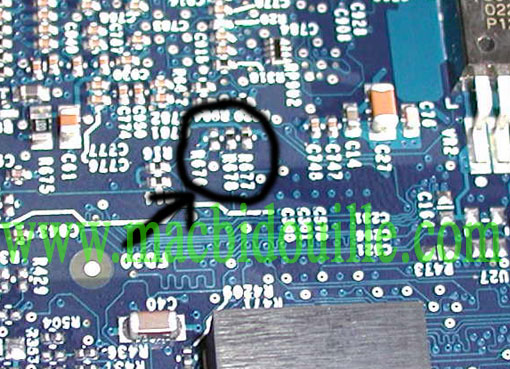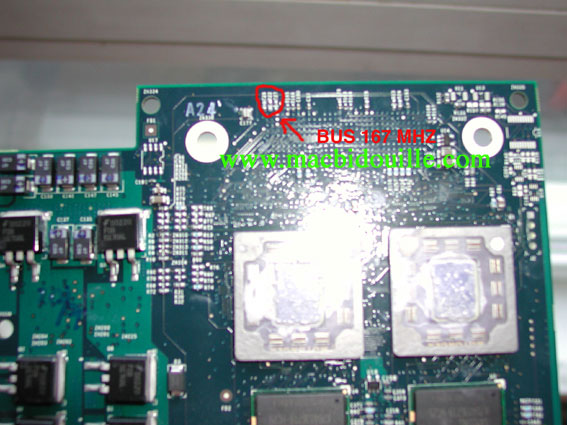i have one.. but im afraid 


after i destroyed my quicksilver 867mhz i am not very brave with hardware mods 
To summarize all this post for
ours MDD 866 there are 2 things to be done. The board is 133 bus and the cpu is 133bus...
On the motherboard back side


for a bus to 167MHz: you must turn in the R676
And you have a 166 bus MDD board (heaven in OS9 I guess). This
needs DDR RAM at 333 instead of 266 (?) so the original memory could not go 333.
You could buy a 166 MDD cpu
or mod the same 866 to be working on 166 bus.

Bus 167 Mhz
R27 nothing, R22 nothing, Resistor R26
Bus 133 Mhz
R27 nothing,Resistor R22, Resistor R26
The thing that everybody talks about is that the 866 at 166 make fail the cache of the cpu,
I have succesfully overclocked Dual G4 867mhz machine by changing the FSB from 133mhz to 166mhz, I removed the two resistors, R676 and R22. I have tested that the machine is stable in Xbench 1.3, Geekbench and in normal usage. G4 chips in my machine are RX933PC so they are rated for 933mhz and now working at 1080mhz.
But, I looked up the Samsung L3 cache chips on my processor card and as far as I know, they are rated for 250mhz (-HC25). L3 cache in MDD models with 1MB of it operate at 4:1 ratio, meaning that the cache in my machine is already operating out of spec, at 270mhz.
and also is recommended to take down the multiplier from 6.5 to 6.
From bits and multipliers...


Step 3. The table below outlines the PLL_EXT and PLL_CFG[0-3] settings for different bus and CPU speeds. For this example I am starting with a stock 1250MHz speed (7.5x multiplier) setting and upgrading to 1500MHz (9x multiplier) setting. The first number in the fields of the first column represents the PLL_EXT resistor and the following 4 numbers represent PLL_CFG[0], PLL_CFG[1], PLL_CFG[2] and PLL_CFG[3] resistors.
Example: 167MHz system bus and 1250MHz (7.5x multiplier) CPU speed is represented as:
PLL_EXT = 0 (resistor or bridged)
PLL_CFG[0] = 0 (resistor or bridged)
PLL_CFG[1] = 0 (resistor or bridged)
PLL_CFG[2] = 0 (resistor or bridged)
PLL_CFG[3] = 1 (no resistor or open)
Our target speed is 1500MHz (9x multiplier) - This is represented as:
PLL_EXT = 1 (no resistor or open)
PLL_CFG[0] = 0 (resistor or bridged)
PLL_CFG[1] = 1 (no resistor or open)
PLL_CFG[2] = 1 (no resistor or open)
PLL_CFG[3] = 1 (no resistor or open)
There in
http://web.archive.org/web/20110722181011/http://bitsandpieces.info/Multipliers.htm is a table that says that our 866 on 166 would be 1083Mhz with
Search for the "PLL Multiplier Config + Actual Speed on given bus" table.
Try to buy the smallest soldering iron you can buy. For the JBC solders here in Europe you can find very thin tips for.
We have to be brave to live this era

 Author
Topic: MDD 866 Mods (Read 64503 times)
Author
Topic: MDD 866 Mods (Read 64503 times)
